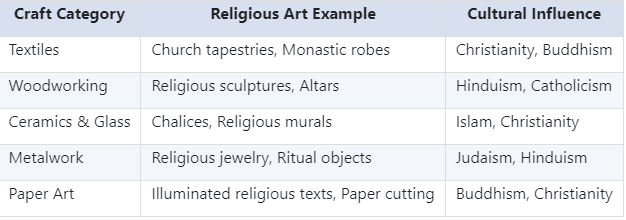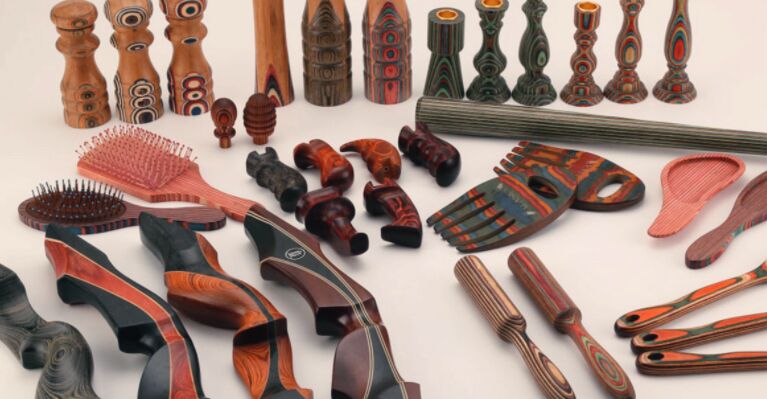·The Definition and Meaning of Craft
·The Relationship Between Art and Religion
·The Meaning of Religious Art
·The Boundaries Between Art and Craft
·Decorative Arts, Applied Arts, and Crafts
·Types of Craft
·The Role of Religion in Culture
The Definition and Meaning of Craft
Craft, as a means of creative expression, communication, and self-definition, is a primordial aspect of human existence and a constitutive factor in the evolution of religion.Through visible expression and form, art gives meaning and value to human aspirations, encounters, and narratives, while positioning humanity within the perspective of community, the world, and the universe.Thus, art makes the human condition, origin, existence, death, and afterlife understandable through visual representation.
The Relationship Between Art and Religion
As a stimulus to creativity and culture, religion is a spiritual impulse that imparts divinity through spiritual experiences, rituals, and myths.Art and religion merge through ritual practices and the presentation of divine narratives, thereby influencing the “experience of the supernatural.”Mysteriously, art can recognize and project the nature and meaning of a spiritual experience through form, thus producing a tangible record that informs the initiation or repetition of the original spiritual moment.Accordingly, art uses visual archetypes and idealizations in its journey to truth and beauty, thus providing a divine vision and a model to follow on the way to salvation.
The Meaning of Religious Art
As visible religion, art conveys religious beliefs, customs, and values through images and depictions of the human body.The basic principle of the interrelation between art and religion is the interaction between image-making and meaning-making, that is, the creative correspondence between humanity and divinity.
There are many ways to define religious art. We can say it is:
1.Any artwork with a Christian or biblical theme (Christian art);
2.Any artwork depicting the worship of any deity;
3.Any artwork with a theme of Islam, Buddhism, Hinduism, Sikhism, Juche, Judaism, Baha’i, or Jainism, or any artwork depicting a theme of Shinto, or traditional Chinese religions.

But on further analysis, these definitions relate to religious “content” rather than religious “quality.”For example, a painting of a crucifixion scene that draws attention to some fundamentally bizarre or profane physical attribute of a dying Christ hardly deserves to be described as religious art.In addition, certain religions (Orthodox, Islamic) have certain rules about the types of art allowed: a sculpture of Muhammad would be considered blasphemous, not religious art.Thus, to qualify as “religious,” the painting, sculpture, or building in question must have some sort of identifiable moral narrative that gives the work the necessary divine “quality.”As with the assessment of all art, determining whether such a moral attribute exists is essentially a subjective act, although in most cases the answer is likely to be fairly simple.
Therefore, our proposed definition of religious art is this:Religious art is any work whose subject matter supports the moral message of the religion it is intended to illustrate.Religion, in this context, refers to any human belief related to something they holy spiritual, or sacred—whether or not deities are involved.
The Boundaries Between Art and Craft

The term “craft” denotes a skill that is often applied to a branch of decorative arts (such as ceramics) or a related artistic practice (such as lace-making).
A key feature of crafts is that they involve a high degree of “hands-on” craft (hence the common name “handicraft“) rather than just machine skills. Some crafts created by artists alone are sometimes referred to by the vague term “studio craft”.
Metalworking, woodturning, glassblowing, and glass art are all examples of “studio crafts”, as is pottery—particularly the studio pottery movement represented by Bernard Leach in the UK.
Decorative Arts, Applied Arts, and Crafts
Due to the expansion of closely related fields such as “decorative arts” and “applied arts,” the etymology and unique meanings of terms such as “art” and “craft” have become more complex and confusing.
“Decorative Arts” has traditionally been considered to include decorative and functional works in ceramics, glass, metal, wood, and textiles. The term covers pottery, furniture, furnishings, interior design, and architecture, and is used by art critics to distinguish these fields from “fine arts” such as painting and sculpture: “fine arts” are created purely for aesthetic reasons (“art for art’s sake”).
“Applied art” describes the field of creative activity that applies design and aesthetics to practical objects for everyday use. (Make useful things beautiful).It includes activities such as architecture, interior design, graphic design, fashion design, industrial or commercial design, decorative arts, and functional arts and is considered as applied arts.The Bayeux tapestry is an example.
Types of Craft
As you can see, there is a clear overlap between these three areas: between decoration, applied arts and crafts, and (indeed) unique crafts and fine art sculpture.
There are hundreds or even thousands of different handicrafts. The following list of crafts is for illustrative purposes only.
1.Textiles: crochet, embroidery, felt-making, knitting, lace-making, quilting, tapestry art, weaving.
2. Woodworking: wood carving, woodworking, cabinet making, furniture making.
3. Paper technology: paper model, collage, paper cutting, origami, paper type.
4. Pottery and glass crafts: ceramics (pottery, stoneware, porcelain), mosaic art, glass bead making, glass blowing, glass etching.
5. Other crafts: basket making, beer making, bookbinding, doll making, enamel, floral design, flower path, jewelry making, knife making (knives), leather products, metal products, model making, tattoo design, toy making.
The Role of Religion in Culture
Religion is central to the lives of people in most cultures around the world; more than eight out of ten people in the world identify with a religious group. Like culture itself, religion is highly dynamic and constantly changing in terms of interpretation and allegiance. It shapes not only individual beliefs and moral codes but also societal norms and, often, political structures. The interplay between religion and culture is evident in the way religious practices, festivals, and symbols are woven into the fabric of everyday life, influencing art, architecture, literature, music, and other cultural expressions.
In conclusion, the relationship between art, craft, and religion is a complex and multifaceted one. Art and craft both serve as vehicles for religious expression and cultural identity, with each form contributing to the rich tapestry of human experience. Whether through the visual storytelling of religious art or the tactile beauty of handicrafts, these creative endeavors reflect the depth and diversity of human spirituality and the enduring role of religion in shaping our cultural heritage.

